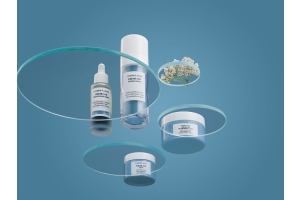The balance of effective exfoliation with the nourishing effects of a face mask is key to any anti-aging skincare routine. You might have heard that the famous Queen Cleopatra would bathe in milk, giving her an ageless glow. Whether this is true or not, one thing is sure, there is effectiveness in using milk, or more precisely lactic acid for skincare. Here’s an overview of this gentle yet powerful acid.
What Is Lactic Acid in Skincare?
Lactic acid is part of the alpha hydroxy acid (AHA) family. What does lactic acid do? Like all other AHAs, it is a chemical exfoliant with many benefits for the skin. One lactic acid benefit that sets it apart from other AHAs is its capacity to keep skin hydrated. It’s the gentlest acid of its category.
What is lactic acid? Our bodies produce this acid when carbohydrates are broken down to produce energy. No worries, this is not the type you’ll find in your skincare product!
Lactic acid in skincare can come from milk, as it is produced by the fermentation of lactose. However, lactose isn’t the only carbohydrate that can result in lactic acid production. It can also be made with corn, sugar and other vegetal carbohydrates.
If you prefer using vegan products, you can indeed find lactic acid-based formulas that do not contain any animal ingredients.
What Does Lactic Acid Do to Your Skin?
If you are wondering what does lactic acid do to your skin, know that it acts on your skin in two ways. First, it’s a chemical exfoliant that helps peel off the layer of dead skin, evening out your complexion and giving you brighter skin. It also has some natural hydrating qualities, which result in extra moisture for your skin.
Used regularly, it can help you have smoother and hydrated skin. Among the many benefits of lactic acid for skin is reducing dark patches, sunspots, and age spots. Thanks to its antimicrobial properties, it can help clean your pores and clear acne.
Since it is a very gentle acid, it works well for sensitive skin. It can even help with several skin conditions. For psoriasis, lactic acid can help soften and remove the scales and reduce itching for eczema-prone skin. As acne-prone skin is usually more sensitive to rough exfoliation, it’s a perfect solution for gently but efficiently deep cleaning the skin.
What Are the Disadvantages of Lactic Acid?
No product is perfect and there are lactic acid side effects on the skin. Like all chemical peels, it can cause redness, itching, swelling, or a burning sensation. Lactic acid is the most gentle AHA, but as an exfoliant, it’s still important not to overdo it.
This product can cause some sun sensitivity, so make sure to protect your skin with sunscreen and avoid direct exposure when the sun is too strong.
Please note that it’s best to avoid using retinol or other topical retinoids while using lactic acid, as mixing them could irritate your skin.
If you are using any skincare prescribed by your doctor, ask before using over-the-counter lactic acid.
Can I Use Lactic Acid on My Face Every Day?
It depends! If you buy lactic acid skincare at the pharmacy, they are most likely to have a concentration of 10% or less. In fact, most products you’ll find will have a concentration of around 5%, which can be gentle enough for daily use. If you are just starting, it is better to try it every other day, at a low concentration. Once you are sure your skin is handling the acid well, you can use it more frequently or use a product with a slightly higher concentration.
However, you do not need to use it every day to see results. Three to four times a week is enough to benefit from lactic acid. Like most skincare regimens, it can take a few months to notice changes in your skin, so be patient.
Lactic acid can be found in several products and will have different concentrations. Some will be more suited for specific skin types. For example, at-home peels or masks can be used weekly, but cleansers can be used every day. Cleansers with lactic acid are great for sensitive skin because the acid is rinsed off.
If you are using a cream or a serum, it’s best to use it at night, to avoid sun exposure. You should still use sunscreen daily, no matter how often you use lactic acid. Using this type of product at night helps renew your skin, as this process occurs while you sleep.
You can also treat your skin with a professional lactic acid peel from a cosmetician or a dermatologist. These have higher concentrations of acid and are often used to target blackheads or dark spots.
A Gentle Path to Radiant Skin
Lactic acid strikes the perfect balance between gentle exfoliation and hydration, making it ideal for various skin types. Used regularly and with care, it can help reveal smoother, more radiant skin. Just be sure to protect your skin from the sun and give it time to show its benefits.







Enter the email associated to your BeautySense account and we'll send you a link to reset your password.